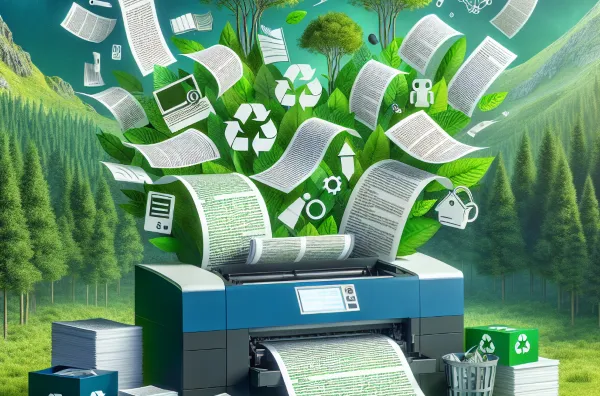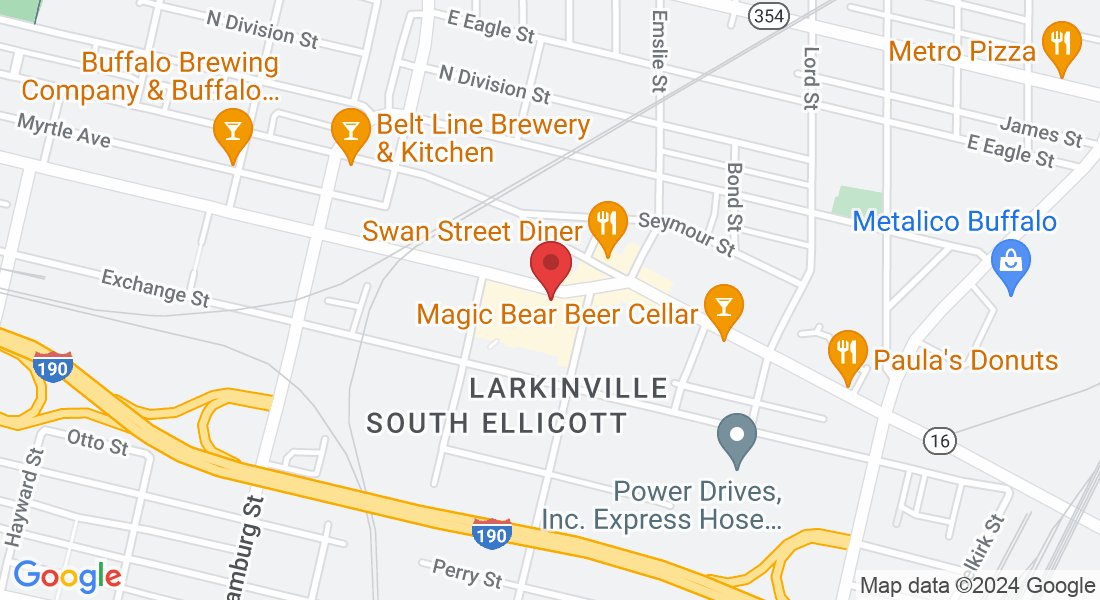BLOG

The Rise of Eco-Friendly Printers: Advancing Sustainability in the Print Industry
The Rise of Eco-Friendly Printers: Advancing Sustainability in the Print Industry
As the world continues to face mounting environmental challenges, industries across the globe are being called to innovate with sustainability in mind. The printing industry, traditionally associated with high paper and ink consumption, has seen a shift towards more eco-friendly solutions. Eco-friendly printers have emerged as a response to environmental concerns, offering businesses and consumers a way to print more sustainably.
The Evolution of Eco-Friendly Printers
Eco-friendly printers are designed to minimize the environmental impact of printing. They achieve this by reducing waste, conserving energy, and using sustainable materials like eco-friendly ink and recycled paper. The journey toward eco-friendly printing began with early efforts to address the harmful effects of traditional printing methods, such as excessive waste and the depletion of natural resources. Over time, advancements like inkjet printers with refillable ink tanks, such as the Epson EcoTank series, gained popularity for their reduced need for frequent ink cartridge replacements.
The development of supertank printers, which use large ink tanks, marked another significant step forward. These printers use refillable tanks instead of cartridges, reducing waste while also improving printing efficiency. This shift has set a new standard in the industry, inspiring other manufacturers to pursue similar technologies.
Addressing Environmental Concerns in the Print Industry
The print industry has long been criticized for its significant environmental impact. Traditional printing methods consume vast amounts of paper, energy, and non-biodegradable ink, leading to deforestation, air pollution, and waste accumulation. Three major environmental challenges stand out:
Deforestation: Paper consumption is a primary driver of deforestation, which harms ecosystems and contributes to climate change. The United Nations has highlighted the importance of responsible consumption to preserve global forests.
Air Pollution: Petroleum-based inks release volatile organic compounds (VOCs), which contribute to air pollution and are harmful to human health.
Waste Accumulation: The widespread use of disposable ink cartridges has resulted in significant waste. Many cartridges are non-recyclable and end up in landfills, contributing to the growing global waste crisis.
In response to these challenges, the printing industry has made strides toward adopting more sustainable practices. From the development of eco-friendly ink technologies to the introduction of printers designed to reduce waste, the industry is gradually shifting toward greener alternatives.
Innovations Driving the Shift Towards Sustainability
The shift to more sustainable printing practices is driven by both innovation and a reassessment of existing business models. Several technological advancements have played a key role:
Eco-Friendly Ink Technologies: One of the most significant innovations in eco-friendly printing is the development of vegetable-based inks and eco-solvent inks. These inks are less harmful to the environment compared to traditional petroleum-based inks. Eco-solvent printers use these inks to provide high-quality printing while reducing harmful emissions.
Refillable Ink Tanks: Printers like the Epson EcoTank series use refillable ink tanks instead of cartridges, which reduces plastic waste and extends the life of the printer. These ink tanks can hold large quantities of ink, reducing the need for frequent refills and decreasing waste. The adoption of such models has become increasingly common in both home and office settings.
Energy-Efficient Printing: The push for energy-efficient technologies has also influenced the evolution of eco-friendly printers. Newer models are designed to consume less energy during operation, and many come with features like automatic power-off to reduce electricity use when not in use.
The Economic Benefits of Eco-Friendly Printers
Sustainability is not just an ethical choice; it also makes good business sense. Businesses that adopt eco-friendly printing technologies often experience significant cost savings. Eco-friendly printers typically have lower operational costs due to reduced ink consumption and fewer maintenance requirements. The long-term savings associated with using refillable ink tanks and energy-efficient devices can offset the higher initial investment costs.
Additionally, many governments offer financial incentives, tax credits, and rebates to businesses that implement sustainable practices. These incentives can significantly lower the cost of adopting eco-friendly technologies and encourage businesses to invest in greener solutions.
Sustainable Printing Practices for the Modern Workplace
The push for sustainability in the printing industry has resulted in the development of several innovative practices designed to minimize environmental impact:
UV Printing: This technology uses ultraviolet light to dry or cure ink as it’s printed. UV printing reduces the number of VOCs released into the atmosphere, making it a more environmentally responsible option compared to traditional printing methods. It also provides high-quality, durable prints on a variety of materials.
Digital Printing: Unlike traditional printing methods, which require plates and extensive setup, digital printing prints images directly from a digital file. This method uses less paper and energy and eliminates the need for consumable materials like printing plates, reducing waste. Digital printing is also faster and more efficient, making it an attractive choice for businesses with high-volume print needs.
Carbon Balanced Printing: To offset the carbon emissions produced during the printing process, some companies are investing in carbon offset programs. By supporting renewable energy projects or reforestation efforts, businesses can neutralize the carbon footprint associated with their printing activities.
Eco-Friendly Materials in Printing
The use of sustainable materials is a critical component of eco-friendly printing practices. Several materials are now commonly used in the printing industry to reduce environmental impact:
Eco-Solvent and Vegetable-Based Inks: These inks are made from renewable resources and do not contain harmful solvents, making them safer for both the environment and the user. Many printers now offer the option of using eco-solvent inks, which help reduce the emission of harmful chemicals into the atmosphere.
Recycled Paper: Recycled paper is made from post-consumer waste, reducing the need for virgin wood pulp. It requires fewer resources to produce and helps divert waste from landfills. Many printer manufacturers now offer products that are designed specifically for printing on recycled paper, supporting a circular economy.
FSC-Certified Paper: The Forest Stewardship Council (FSC) certifies paper that comes from responsibly managed forests. By using FSC-certified paper, businesses can ensure that their printing materials are sourced sustainably, helping protect forests and biodiversity.
The Role of Equipment Design and Disposal Practices
Eco-friendly printing is not just about using the right ink or paper—it’s also about how printers are designed and disposed of. Manufacturers are focusing on creating devices that are easier to recycle and made from materials that can be repurposed or reused. For example, some printers are designed with modular components that allow parts to be replaced or upgraded, extending the life of the machine and reducing waste.
When it comes to disposal, companies are also implementing responsible practices. Instead of sending old printers to landfills, many are offering recycling programs that allow customers to return their used printers for proper disposal or repurposing.
The Future of Eco-Friendly Printing
The future of eco-friendly printing looks promising, with technological advancements and growing consumer demand for sustainable products. The printing industry is likely to continue evolving, incorporating new innovations to further reduce its environmental impact. Key trends shaping the future of printing include:
Increased Use of Renewable Energy: As more businesses seek to reduce their carbon footprints, the use of renewable energy in the printing process is expected to grow. Solar-powered printers and other green technologies could become more prevalent in the coming years.
Smarter Printing Technologies: Advances in artificial intelligence and automation will likely play a role in making printers more energy-efficient and waste-conscious. By optimizing print jobs, these technologies can help reduce unnecessary printing and paper waste.
Circular Economy Practices: As the industry continues to shift toward a circular economy, the focus will be on extending the lifespan of printers and consumables through repair, reuse, and recycling programs. Manufacturers will increasingly design products with the end of life in mind.
Real-World Examples of Eco-Friendly Printing Solutions
Many companies are already adopting eco-friendly printing practices. For example, leading manufacturers like Epson have developed printers with refillable ink tanks that significantly reduce plastic waste. Other companies, such as Canon and HP, are integrating energy-efficient technologies and offering recycling programs for used ink cartridges.
These innovations have made eco-friendly printing accessible to both small businesses and large enterprises. By adopting these technologies, companies can improve their environmental footprint while also enjoying cost savings and efficiency gains.
Conclusion
The evolution of eco-friendly printers represents a significant shift in the printing industry, one that prioritizes sustainability without sacrificing quality or efficiency. As new technologies emerge and businesses embrace more responsible practices, the print industry is making strides toward reducing its environmental impact.
While challenges remain, the industry’s commitment to innovation, along with growing consumer demand for sustainable products, suggests that the future of printing is bright. By continuing to invest in sustainable technologies and practices, the printing industry can help preserve the planet for future generations while meeting the needs of today’s eco-conscious consumers.
Copyright © 2024. QLS Solutions Group. All Rights Reserved | Terms & Conditions | Privacy Policy






